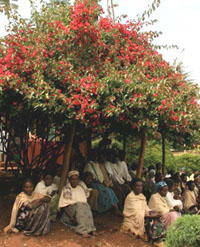4.6 Conducting meetings
Meetings are a necessary part of the Health Extension Programme because meetings are the way in which health teams communicate with people in their locality (Figure 4.6).

In the delivery of health services to the community you may be able to use a variety of different types of meetings:
- Large public meetings, often held in the open air, to encourage people to express their views on a community health problem or to inform and explain something new to the community.
- Small meetings often held with community leaders to identify health problems and needs.
- Meetings with special groups, such as young people or mothers, for the specific purposes of health education.
- Regular meetings of the health team.
- Committee meetings, which may be important in making decisions about new ideas.
- Discussion groups to learn new skills, techniques and approaches.
Box 4.5 Planning your meetings
When preparing for a meeting it is useful to plan the following:
- purpose of meeting
- main subject matter
- type of meeting
- size of meeting
- place, time and duration of meeting
- who is convening and organising the meeting
- announcement or information about the meeting.
Look carefully at Box 4.5. Imagine that you want to hold a meeting to tell local mothers about their contraceptive choices. What planning would you do before the meeting started?
The more planning that you do before the meeting the more likely it is to run smoothly. You certainly need to cover all the points in this box and be sure that all these items are clear in your mind.
4.5 Training your team
